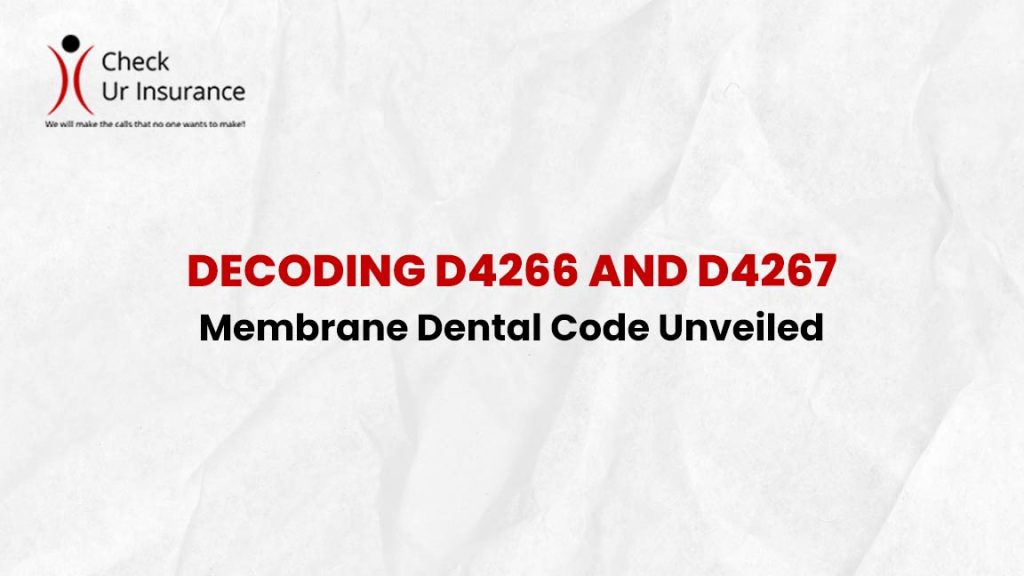Decoding D4266 and D4267: Membrane Dental Code Unveiled
Dive into the intricacies of D4266 and D4267, the membrane dental codes revolutionizing dental procedures. Here we’ll dissect these codes, shedding light on their applications, procedures, and significance in the realm of guided tissue regeneration.

Table of Contents
D4266: Guided Tissue Regeneration – Resorbable Barrier
Unveiling the Procedure D4266 dental code, where guided tissue regeneration meets the use of resorbable barriers. This section breaks down the procedure, emphasizing its role in addressing periodontal and peri-implant defects. Understand how this code contributes to osseous regeneration without flap entry and closure.
Inclusions and Exclusions Decipher the specifics of D4266, including what’s covered and what’s not. From wound debridement to osseous contouring, bone replacement grafts, and biologic materials, get a comprehensive overview of the inclusions and exclusions of this code.
D4267: Guided Tissue Regeneration – Non-Resorbable Barrier
Untangling the Procedure Delve into the details of D4267, where guided tissue regeneration takes the form of a non-resorbable barrier. This section dissects the procedure, emphasizing its applicability in periodontal and peri-implant defects. Grasp how this code aids osseous regeneration without flap entry and closure.
What’s Covered and What’s Not Navigate the landscape of D4267, understanding the procedure’s inclusions and exclusions. From wound debridement to osseous contouring, bone replacement grafts, and the removal of the membrane, gain insights into the comprehensive nature of this dental bone graft code.
Choosing Between D4266 and D4267: A Decision-Making Guide
Tailoring Treatment Plans Explore the considerations that guide the choice between D4266 and D4267. This section provides valuable insights for dental professionals, helping them tailor treatment plans based on patient needs and specific defects.
Patient Expectations and Recovery Understand what patients can expect from D4266 and D4267 procedures. From the initial stages to recovery, this section offers a realistic overview, ensuring both dental professionals and patients are well-informed.
Expert Opinions: Advancing Dental Care Through Membrane Dental Codes
Professional Perspectives Tap into the expertise of dental professionals as they share their perspectives on D4266 and D4267. Learn from their experiences and gain valuable insights into the evolving landscape of guided tissue regeneration in dentistry.
Innovations Shaping Membrane Dental Codes Stay abreast of the latest innovations influencing membrane dental codes. Discover how technological advancements are enhancing the effectiveness of D4266 and D4267 procedures, contributing to better patient outcomes.
FAQs About D4266 and D4267 Membrane Dental Codes
Is the removal of the membrane included in both procedures?
Yes, the removal of the membrane is specifically mentioned in D4267, making it an integral part of the procedure.
Can D4266 and D4267 be used for any dental defects?
Both D4266 and D4267 are designed for addressing periodontal and peri-implant defects, offering targeted solutions for specific dental issues.
Are these procedures covered by dental insurance?
Insurance coverage for D4266 and D4267 may vary, and it’s advisable to consult with your insurance provider for specific details on coverage.
How long does recovery take after D4266 or D4267 procedures?
Recovery times depend on various factors, but patients can generally resume normal activities within a few days to a week after either procedure.
What factors influence the choice between D4266 and D4267?
The choice between these codes depends on factors such as the nature of the defect, patient preferences, and the recommendations of dental professionals.
Is guided tissue regeneration painful for patients?
Patients may experience some discomfort, but these procedures are typically performed under anesthesia to minimize any pain during the process.
Conclusion
D4266 and D4267 membrane dental codes stand at the forefront of guided tissue regeneration, offering tailored solutions for periodontal and peri-implant defects. Stay informed, consult with your dental professional, and embrace the advancements these codes bring to the field of dental care.
Did you like this article? Read more helpful latest blogs.
